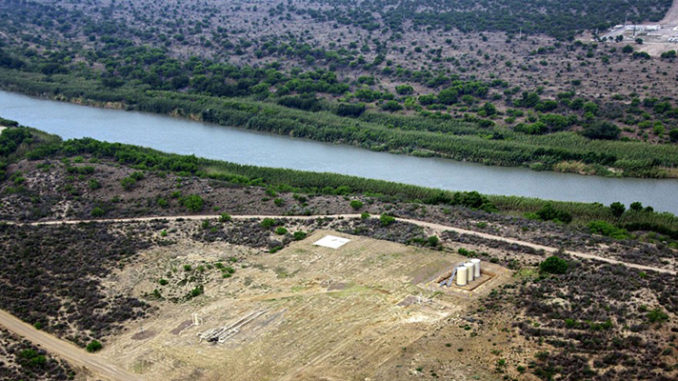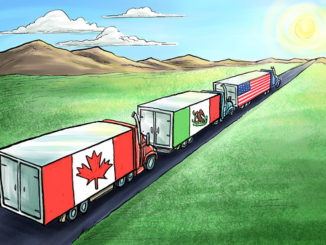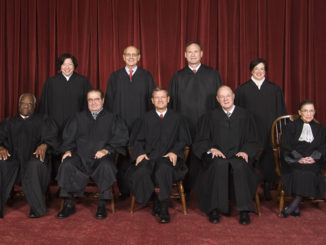
by James Andrew Lewis
This is not the first time there have been calls for the United States to build a wall along its southern border. The fate of the 2006 Secure Fence Act gives us an idea of the problems a new wall will face.
First, no matter how tall the wall, it can be scaled. If you build a 12-foot wall, people buy 14-foot ladders. Who knew there were hardware stores in Mexico? The Berlin Wall was only 12 feet high but was savagely guarded by an inordinate number of heavily armed border police. We could make the wall especially high, like the walls of ancient Rome (which were between 30 and 50 feet high), but this would be expensive, and there would still be ways around, including tunneling. Illegal crossers (narcotraficantes are the best) will use both longer ladders and deeper tunnels, and since they’ve already made the investment in ways to get over, they can make additional money by smuggling humans.
One goal in 2006 was moving from a “dumb” wall to a “smart” wall, lined with sensors. The smart wall had problems. First, the sensors then had a lot of “false positives,” setting off alarms and alerting to the presence of rabbits, coyotes, or stray cows. Perhaps with the passage of time, the false positive problem has been fixed, but sensors are not a panacea. Even when they are mounted on tall poles, sensors can be vandalized. People cut wires or sprayed paint on lenses or moved things in front to block the view. Narcotraficantes did this, human smugglers did it, and some border residents did this because they received “emoluments” from smugglers for looking the other way when crossings took place—emplaced sensor hurt business.
The Department of Homeland Security (DHS) began flying unmanned aerial reconnaissance aircraft along the border to detect people trying to cross. Drones are one successful legacy of the 2006 effort and drew on our experience in using unmanned aerial vehicles (UAVs) in the Middle East. UAVs are a good idea (smugglers use smaller drones to scope out border entry points), but the secret to walls, sensors, or drones is that these things only work if you can send agents in response to a detected crossing. The only way to control the border is a police presence and robust patrolling. Patrols need good communications, if only to receive alerts from sensors or drones, and a high degree of mobility. The key to border control is enough agents who have good mobility and communication and there has been some progress in this.
Although Customs and Border Patrol (CBP) is unpopular with some, it has done well in the decade since the Secure Fence Act was passed, building capability to process data from UAVs and sensors, creating a more reliable communications network, and improving command and control. One sign of this is that the price of being smuggled across the border has gone up. CPB would tell you that their problem is not catching people but what to do with them afterward. Catch and release only encourages another try. A wall is irrelevant to this problem. Stemming the flow of migrants requires more than a wall (although a wall, of course, has greater visual appeal and done the right way, might even become a tourist attraction like the Great Wall of China).
What to do when you catch a crosser is a legal problem, exacerbated when there are thousands of them. Poor people in unsafe developing countries are driven to flee in increasing numbers, but as the experience of Europe shows, a developed society can only absorb so many without harm. The practice around the world is to briefly jail illegal entrants and then deport them to their country of origin, but this worked best before the age of mass migration, something for which no wealthy nation was prepared. Europe’s response has been to let some in, tolerate squatter camps, or relocate illegals to a secluded island. But this does not make the problem go away; it only postpones the day of reckoning, when you either let them in or send them back. Draconian punishments are unwarranted. Fixing catch and release requires clarifying the legal status of crossers. The United States has wrestled with this for decades. In the nineteenth century, these people would have been welcomed (although immigrants, starting with the Irish, met with nativist hostility). In the twentieth century, the United States has veered between restriction and openness, driven by tensions between economics and politics.
Immigrant flows used to be driven by demand for labor, and one solution would be to let the market determine the size of these flows (meaning when there is demand for workers, we let people in). Workers migrate to higher wage locations, and the United States will always be a draw. Many illegals come to the United States to perform work that most Americans avoid, like harvesting crops, and there are seasonal upticks in border crossings. In an ideal world, the United States would take a pro-business approach and let this seasonal workforce enter, accepting the risk that some would stay on to become dishwashers or yard workers, but a pro-business solution to immigration has so far proven elusive. Visas for highly skilled workers, known as H1B visas, pose a different economic and employment problem. In any case, these skilled individuals are not crossing the border illegally. There are problems with the allocation of benefits for a market-driven policy (Do illegal kids get to go to public school?), but most illegal crossers are young adults, eager for work, and the benefits of adding them to the workforce probably outweigh the costs.
Threatening statements by senior officials have a deterrent effect, but this lasts only so long and can reflect badly on both officials and the nation. A better strategy would change the things that drive people to cross the southern border. The best way to do this would be to work with Central American countries to improve in-country opportunity and reduce crime—this is known as foreign assistance. Foreign assistance has the advantage of pushing out our first line of defense and building partners and markets. Foreign assistance to reduce incentives to enter illegally would take the pressure off CPB. It might even be cheaper than building a wall.
The United States is lucky if we compare its illegals to those entering Europe. Asian immigrants bring real economic benefit. We have cultural affinities with Central Americans, if only because it is one of the few places in the world where baseball is a major sport. Why we want to discourage hard-working baseball fans from coming to the United States is another question, but every country has a right to control its borders, and the United States cannot afford to offer shelter to the citizen of every impoverished nation. Political asylum, which was intended to apply to the victims of state-sponsored violence, is not the answer to foreign poverty and crime. A rational immigration policy, rather than a mélange of authorities (some of which date back to the nineteenth century) would best serve the national interest but is politically infeasible.
We can’t expect to hermetically seal a border that is almost 2,000 miles long. And as long as Americans are willing to spend billions of dollars on illegal drugs, there will be incentives for people to cross illegally. A real solution requires laws that balance the United States’ economic need for immigrants with the political imperative for border control. There will always be a cross-border flow, and the United States needs to manage it. A good border security package would have the following elements:
- Physical obstructions (like walls) at high traffic areas
- More patrols
- A sensor net in depth (meaning layers of sensors)
- More UAV flights along the borders
- Quicker turnaround for justifiable deportations
- Aid packages to Central American countries fight crime and build governance and economies
- Good cooperation with Canada and Mexico
- Legislation that modernizes immigration law for labor supply and for mass migration
Some of these measures are already in place, but the United States needs all of them.
NB: Judging from the public record, no jihadis have slipped across the southern border since the founding of the Republic (in part because of help from Mexico in border security). Nor is there any correlation between illegal immigration and serious crime. Illegal border crossing is a social and economic problem, and a misdemeanor, not a national security issue.
James Andrew Lewis is a senior vice president at the Center for Strategic and International Studies in Washington, D.C.



